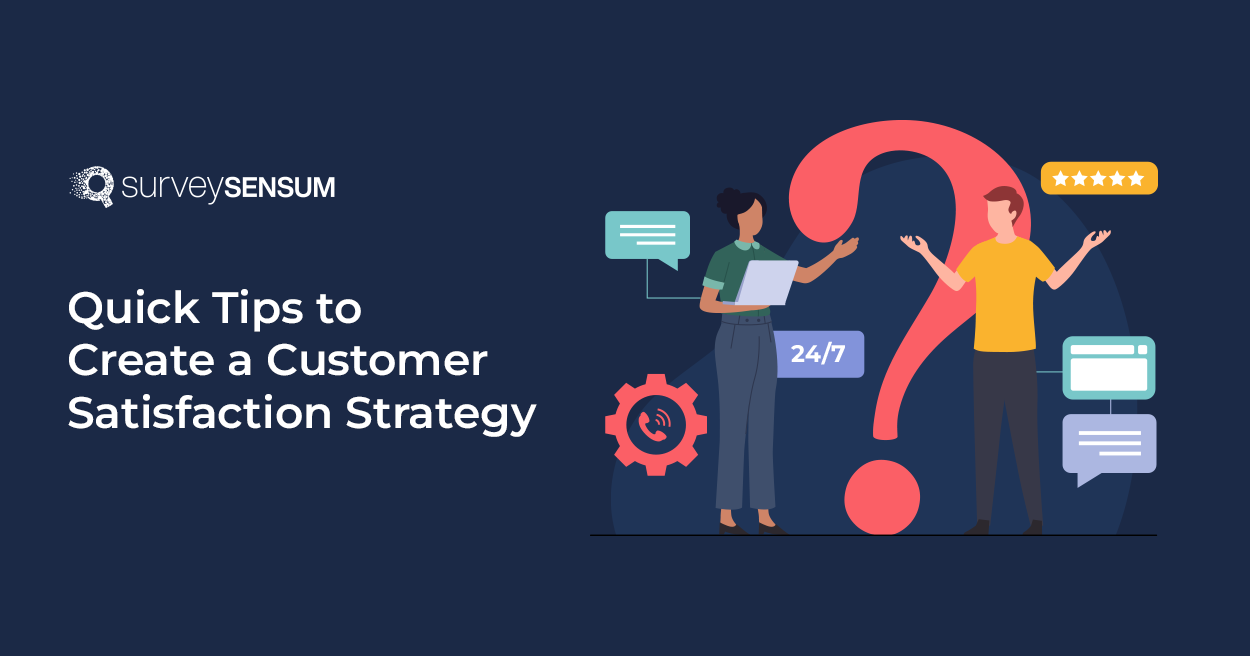
Developing a robust customer satisfaction strategy is essential for any business that aims to improve customer satisfaction, enhance brand loyalty, and drive growth.
According to a recent article, “The Five Disciplines of Customer Experience Leaders” by Bain & Company, excelling in customer experience can have a significant impact on a company’s revenue. In fact, companies that prioritize customer experience have been found to grow their revenue by 4-8% above their market average.
These compelling numbers underscore the importance of customer experience and emphasize that it should not be taken lightly.
An excellent example of a company that has successfully implemented customer-centric initiatives is Amazon. Through initiatives such as fast and reliable shipping, easy returns, personalized recommendations, and exceptional customer service, Amazon has positioned itself as a leader in delivering a positive customer experience.
The positive correlation between customer satisfaction and revenue growth is evident in Amazon’s financial performance. In the first quarter of 2023, Amazon reported a significant increase in net sales, amounting to $127.4 billion, representing a 9% growth compared to the same period in 2022.
It’s important to recognize that the impact of customer satisfaction on revenue growth extends beyond Amazon. Many companies across diverse industries have experienced similar benefits by prioritizing and investing in customer satisfaction. This highlights the universal applicability of customer-centric strategies for driving business success.
To help you enhance customer satisfaction in your own business, we have identified eight highly effective strategies that can be tailored to your specific context.
Let’s explore these strategies and discuss how they can contribute to improving your customers’ experience and driving your business forward.
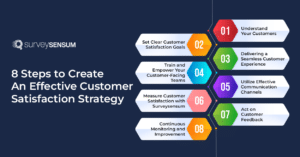
8 Steps to Create an Effective Customer Satisfaction Strategy
Here are the 8 steps to create an effective customer satisfaction strategy for your business. These steps will be beneficial to improve your customer satisfaction.
1. Put Yourself In Your Customer’s Shoes

Crafting a successful strategy requires a deep understanding of your target audience. Without this understanding, any strategy is bound to fall short of its goals.
Let’s say you opened a cafe and aim to serve the best coffee and cookies. Your business is doing great and after a while, you decided to do a survey to find out ways to improve your product and services and found out that many of your customers are looking for some vegan and gluten-free options for cookies and some plant-based milk options for coffees.
But instead of taking that feedback seriously, you ignored it which resulted in to increase in your customer churn rate because certain groups of people were dissatisfied with your products.
This shows the importance of making an effort to understand your customers and take relevant actions.
Customers have multiple touchpoints with your brand, from clicking on your website to watching a product demo or making a purchase. These touchpoints can provide you with crucial information on your customer’s needs and expectations and what you need to improve your customer experience.
To get a better understanding of your customer’s needs and expectations you can incorporate the following techniques into your customer satisfaction strategy:
- Customer journey mapping will help you in understanding your customer interactions and key engagement areas with your brand. Basically why and how customers are interacting with your brand.
- Develop buyer personas to get an insight into their preferences, pain points, and expectations.
- Analyze customer feedback from various sources such as surveys, social media comments, and customer service interactions. Look for common themes, issues, and trends. Analyze both positive and negative reviews and look for areas of improvement.
- Watch recordings of customer interactions by using tools such as Windows Clarity or Hotjar’s Session Recordings, to understand how and where your customers are interacting. Are they facing any difficulties? Why are they leaving midway?
Brand Example: Netflix revolutionized the entertainment industry by understanding the evolving preferences and viewing habits of customers, including the importance of effective web design. Similarly, our tailored web design can help businesses improve website conversions by increasing online presence and driving meaningful engagement.
By leveraging data analytics and algorithms, they personalized the user experience, recommending relevant content based on individual preferences. This understanding of customer needs led to increased customer satisfaction, as subscribers were able to discover and enjoy content tailored to their interests.
As a result, Netflix experienced a significant increase in customer retention and acquisition, driving up their subscription numbers and ultimately boosting profitability. According to a research report by Antenna, the customer churn rate of Netflix was 2.4% in 2021 – which is incredibly low compared to other streaming services like Hulu. Additionally, Netflix’s success underscores the importance of partnering with a reputable web design company to achieve similar results in other industries.

2. Set Clear Customer Satisfaction Goals
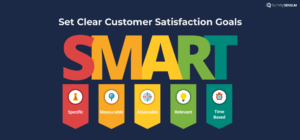
Now that you understand your customer’s needs, expectations, and interactions with your brand, the next step is to set clear customer satisfaction goals that align with your business objectives.
The importance of including this step in your strategy is to provide focus, measurable progress, accountability, motivation, transparency, and an understanding of prioritization to everyone involved in the strategy.
Your team needs to understand what their objectives are and how it helps them achieve customer satisfaction goals for your business. These goals or objectives will provide your team with a measurable framework for assessing their progress on customer satisfaction strategy.
Here are a few points to consider while setting up your customer satisfaction goals:
- Choose a SMART goal framework to create clear and focused goals. This means defining specific, measurable, attainable, relevant, and time-bound (SMART) goals.
- Define your key metrics that will serve as your indicators for customer satisfaction. Some common metrics that you can include are the CSAT score, NPS score, Customer Retention Rate, and CLV. Choose the metric that is relevant to your business and aligns with your objectives.
- Asses your previous customer satisfaction score, historical data, customer feedback, and survey results and establish a baseline. This baseline will help you in tracking improvements and measuring your customer satisfaction strategy.
- Ensure that your customer satisfaction goals are specific and measurable. For example, instead of setting a goal like “improve CSAT”, establish a more specific target, like “increase the CSAT score by 10% in the next 6 months.”
- Align your customer satisfaction goals with your business objectives. For example, if you are looking to increase your revenue from the current customer base then the customer satisfaction goal should be to increase up-sell or cross-sell opportunities through customer loyalty programs.
- Break your customer satisfaction goals into actionable steps. This will help you to make your goals more manageable, allowing you to track your progress incrementally.
Here’s an example:
Let’s say the customer support team of your organization was given the target to respond to customer queries within 24 hours.
This clarity enables them to prioritize tasks, allocate resources effectively, and streamline their workflow. As a result, customers received prompt responses to their inquiries, and they felt valued and supported, leading to higher satisfaction levels.
Additionally, achieving the set goal demonstrates the team’s commitment to providing excellent customer service, reinforcing trust and loyalty among customers.
3. Deliver a Seamless Customer Experience
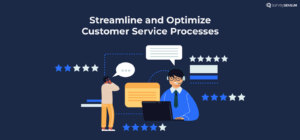
If a customer encounters a bad experience at any point, chances are they will leave your business.
Even PwC’s Experience is Everything report says, 59% of customers have reported that they will leave a brand they love after several bad experiences, and 17% will leave just after one bad experience.
Think about it!
Don’t you always expect a smooth experience when doing business with any brand? So do your customers!
Delivering a seamless customer experience process will help your customers effortlessly navigate through every interaction with your brand.
Here are a few exceptional tips on how you can deliver and create a seamless experience for your customers:
- Map the customer journey to identify touchpoints and opportunities, both online and offline, for improvement. This includes customers browsing through your websites, interacting through your social media channels, making a purchase, offline store visitations, etc.
- Consistency across all customer interactions creates a seamless experience. Ensure that your brand messaging, tone, and visual identity remain consistent across all channels such as your website, social media, email communication, or in-person communication. This consistency builds trust and familiarity among your customers.
- Streamlining your processes to eliminate unnecessary steps and complexities for easy interactions. This could include steps changes like simplifying your checkout process, providing self-service options for common queries, chatbots, etc.
- Your customers tell you exactly what they need and expect. Listen to your customer feedback, gather the data, and analyze them to create action plans. This will ensure a positive relationship between you and your customers as they will feel valued.
- Develop a responsive and proactive customer support team. This can include offering omnichannel customer support, training your customer service staff to be more knowledgeable and empathetic, and answering customers’ questions or issues promptly and effectively.
Streamline Your Customer Service With SurveySensum
4. Train and Empower Your Customer-Facing Teams

When it comes to improving customer satisfaction it is very crucial to train your customer-facing teams to be prompt and responsive as they are like the first line of defense for your brand. This includes salespeople, customer service agents, and any other teams that interact with customers directly.
According to the “State of Connected Customer,” article of Salesforce, 89% of customers are more likely to make another purchase from a brand after a positive customer service experience.
The above statistics show the importance of having a well-trained, knowledgeable, and prompt customer-facing team to spearhead your customer service, but how to ensure that?
Here are a few tips to help you train and empower your customer-facing teams:
- Provide comprehensive training on product knowledge and customer service skills. Provide thorough training to familiarize them with the features, benefits, and unique selling points of your products or services. This will equip them to have extensive knowledge and effectively communicate with your customers and provide them with accurate information.
- Encourage customer-centricity among your employees so that they develop the ability to understand customers’ situations, perceptions, and expectations and empathize with them. Customer-facing employees should be able to handle customer inquiries and complaints professionally and courteously, with the aim of resolving issues and exceeding customer expectations.
- Incorporate customer feedback into the training and development process. Gather feedback from customers about their experiences with your customer-facing teams and use it as a valuable resource for identifying areas of improvement.
- Conduct role-playing exercises and scenario-based training sessions to simulate real-life customer interactions. This helps your teams practice their communication and problem-solving skills in a safe and supportive environment.
Brand Example: Spotify’s fun approach to customer service.
Spotify has a unique and enjoyable approach when it comes to customer support. They go beyond the traditional methods and bring fun into the mix.

For instance, when a user in Canada reached out to them on Twitter, seeking help to understand how Spotify works, the response they received was far from ordinary. Instead of a standard reply, Spotify sent them an instruction manual in the form of playlists! It’s just one example of their creative and amusing customer interactions.

They are also known for quickly resolving their customer’s issues. This user faced some issues regarding her Spotify account and the team replied back to her with an immediate solution within 26 minutes.
They really know how to engage with their users in a lighthearted and entertaining way. But are also quick to reply and resolve the issue at hand.
Spotify takes pride in offering not just great music, but also enjoyable and personalized customer service experience. They constantly find innovative ways to give their customers exactly what they want and, make their interactions memorable and enjoyable.
5. Utilize Effective Communication Channels
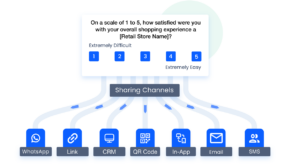
In simple terms, this step means, “Be where your customers are”. This step is all about offering multiple communication channels to your customers such as emails, messaging, chatbots, surveys, and many other channels so that they can communicate with you via their preferred channel.
Here are a few tips to consider for utilizing effective communication channels for your business:
- Adapt an omnichannel approach for customers to reach out and provide feedback. You can use multiple channels like emails, messaging, social media, etc, and engage seamlessly with your customers in their preferred communication channels.
- Respond promptly and professionally to customers’ inquiries and concerns. This will show that you value your customers and their time. Set service level agreements (SLAs) for response times and ensure that your customer-facing teams adhere to these standards.
- Use automated tools to automate and streamline your customer service processes. Automated emails, chatbots, and customer relationship management (CRM) systems can help deliver consistent messages, provide instant responses, and gather customer information efficiently. But make sure to strike a balance between automation and personalization.
Real-life Brand Example: SurveySensum has achieved an impressive 98% retention rate by leveraging multiple communication channels to enhance support. Customers can engage via various channels like websites, social media, WhatsApp, email, chatbots, and calls.
This enables SurveySensum to promptly respond to customer needs, resulting in an impressive 98% retention rate. Our commitment to a 2-hour SLA support response time ensures efficient support and has built an ecosystem that has earned trust and loyalty globally.
Utilize Effective Communication Channels With SurveySensum
6. Measure Customer Satisfaction
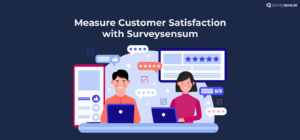
Measuring your customer satisfaction is a crucial step in building an effective customer satisfaction strategy. This allows you to understand the level of satisfaction your customers have towards your products, services, and overall brand experience.
And not just, by implementing effective measurement techniques, you can gain valuable insights into customer experiences, identify pain points, and make data-driven decisions to enhance satisfaction levels.
But how to do that?
- Actively Implement Customer Surveys: Launch well-designed surveys, such as CSAT or NPS, to gather direct feedback on satisfaction levels and promptly analyze the results to identify specific areas for improvement.
- Engage in Proactive Social Media Listening: Harness social media tools to understand what customers are saying, respond promptly, and turn their satisfaction into a driving force for your business.
- Conduct Meaningful Customer Interviews: Conduct insightful one-on-one interviews or focus groups with customers, actively listen to their experiences, preferences, and pain points, and utilize the insights gained to drive improvements.
- Improve Customer Support Interactions: Analyze customer support interactions to identify recurring issues, provide adequate training to the support team, and implement strategies to enhance the overall customer support experience.
- Foster Customer Loyalty: Plant the seeds of loyalty by implementing loyalty programs. Monitor customer retention rates, encourage repeat purchases, and reward referrals.
Brand Example: Allianz wanted to reduce its customer complaints. Allianz was facing issues with solving customer complaints in real-time, impacting their overall satisfaction
They turned to SurveySensum, a customer feedback platform SurveySensum helped Allianz listen to all their customer feedback at all touchpoints, gather feedback in real-time, analyze that feedback, and take data-driven actions.
Impact: This helped Allianz reduce their customer complaints by 23% and boosted overall satisfaction.
7. Act on Customer Feedback
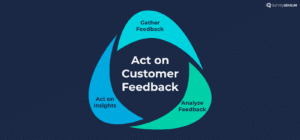
Measuring customer satisfaction is essential – but only if we take action on the feedback gathered from customers.
But, how can we do that?
Here are some tips you can use to act on your customer feedback:
- The first thing you need to do is analyze your customer feedback so that you can prioritize and address customer concerns and suggestions based on survey feedback. Tools like Text Analytics can do this in minutes and give you top trends and sentiments from thousands of customer feedback.
- Now that you have the top complaints to work on, share them with the relevant stakeholders. For instance, if there is a technical issue while creating a request for a refund, share it with the technical team. Or if the customer is unable to navigate through the product, or is unhappy with a certain feature – share it with the product team.
- Implement necessary changes and improvements. This includes streamlining your customer service processes or enhancing your product or service. Involve relevant teams or departments in implementing these improvements and monitor the impact on customer satisfaction.
- At last close the feedback loop. Inform your customers that you’ve listened to their feedback and working on it. Once done, inform that the respective issue is resolved.
While this entire process boosts customer satisfaction, it also encourages loyalty!
8. Continuous Monitoring and Improvement
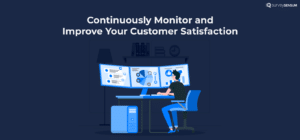
Improving customer satisfaction is not a one-time thing. It is something that requires ongoing effort and attention.
Furthermore, when you implement a strategy to enhance your customer satisfaction, it is crucial to keep monitoring and evaluating its effectiveness. This way, you can identify what’s working well and what’s not, giving you the chance to make improvements where needed.
By continuously assessing and adjusting your approach, you can maintain a consistently high level of customer satisfaction and keep your customers happy.
Here’s how you can implement continuous monitoring and improvement strategies:
- Establish key performance indicators (KPIs) related to customer satisfaction that align with your overall business objectives. These indicators can be your NPS score, customer retention rate, CSAT score, etc. By setting specific targets for these KPIs, you can easily track and measure your progress over time.
- Continue gathering feedback from your customers through multiple channels. This will help you capture the evolving needs and expectations of your customers and give you the opportunity to identify areas of improvement. Implement a systematic approach to collect feedback at regular intervals with surveys, focus groups, etc.
- Analyze the feedback collected to identify trends, patterns, and areas for improvement. Look for both positive and negative feedback to understand what’s working and what needs to be improved. Use this information to prioritize and take action on the most critical issues, making data-driven decisions.
- Periodically review and update your customer satisfaction strategy to ensure that it is relevant and effective. Assess the impact of previous initiatives, analyze new data, and adjust your approach as needed. Regularly communicate the updated strategy to your employees to ensure alignment and consistency.
Key Takeaway
A robust customer satisfaction strategy is crucial for business success. Understand customer needs, set clear goals, and deliver exceptional service. Empower staff, offer seamless communication, and measure satisfaction with reliable tools.
Utilize SurveySensum, an efficient feedback tool, to enhance customer satisfaction and fuel sustainable growth.
How?
With SurveySensum, you can
- Launch CSAT, CSI, SSI surveys, and more
- Collect omnichannel feedback in real-time
- Identify touchpoints with the most friction with journey-based dashboards
- Identify top trends and sentiments from thousands of feedback text analysis in just a few minutes.
- Get instant detractor alerts on your CRM so you can close the loop in time.
- Not just that, the CX team helps you with insights and recommendations on what to do with the feedback gathered and the next steps that can be taken to meet customer satisfaction and improve the overall experience.






